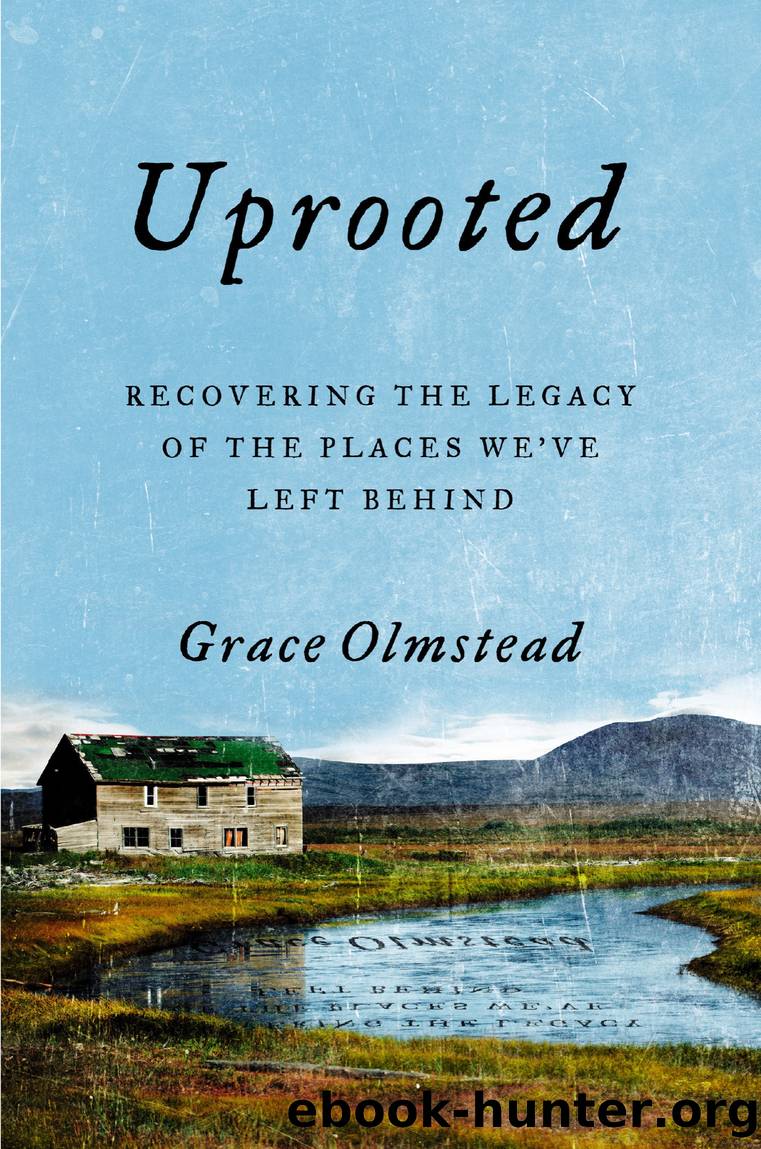Uprooted by Grace Olmstead

Author:Grace Olmstead [Olmstead, Grace]
Language: eng
Format: epub
Publisher: Penguin Publishing Group
Published: 2021-03-16T00:00:00+00:00
* * *
I walk through an apple orchard on the south slopes of Emmett, along rows of manicured trees covered in yellow fruit. The orchard is immaculately maintained: the grass between the trees is clipped short, and everything is free of weeds and debris. Then thereâs the view beyond: of the dusty-colored slopes stretching east toward Freezeout Hill, the clumps of neighboring orchards and suburbs, the irrigation ditches stretching toward town.
âDo you generally think of Golden Delicious apples as crispy?â the orchardâs owner, Lance Phillips, asks me suddenly.
I shrug. âNot particularly,â I say.
Lance quickly picks an apple from a tree and tosses it to me. âTake a bite right now,â he says with a grin.
I bite into the apple with a loud crunch. It is perfectly crispy, its sweet and tangy flavor lingering in my mouth with every bite.
An unripe apple is full of starch. Until it starts producing ethylene gas, which kick-starts the ripening process, an unripe apple wonât taste good. But after the gas has helped convert all that starch to sugar, the apple has a rich crispiness and flavor. Itâs perfect. But hereâs the catch: as soon as a perfectly ripe apple is picked on the tree, it will begin to age and grow mushy. Its shelf life is limited, which can hurt profits and make national or international sales difficult. Because of this, store-bought apples are usually picked just before the fruit has started converting its starch to sugar, and stored in a cold, low-oxygen environment that slows the conversion process. Some sellers will also use SmartFresh, the brand name for synthetic plant-growth regulator 1-methylcyclopropene. SmartFresh binds the appleâs ethylene receptors, thus preventing it from receiving the cue that itâs time to ripen.19
Because of this process, the apples we buy at the store can be up to a year old. Once theyâre finally in the store and on the shelf, the apples begin their ripening process again. But the process of ripening in the store doesnât mirror ripening in the orchard: the apple doesnât have the same deep flavor, aroma, or nutritional complexity.20
As I stand in Lanceâs orchard, tasting one of the best apples Iâve ever had, I realize that this apple is the fruit of a long legacy of work and fidelity. The roots of this orchard go down deep, connecting the present to the past. But the fruit in my hand is also a picture of the constant transformation that happens on a farm: the seasons that perpetually move us forward into growth, decay, and new life.
This orchard was once owned by an Emmett native named Robert Benson (known as Bob), who was born near the very spot I now stand on. He grew up here on the south slopes, helping tend the apple, cherry, peach, and pear trees his father and grandfather cultivated. He joined the U.S. Army Air Corps in 1940 but returned to Emmett after World War II ended and bought fifty-three acres of his own, just a few miles northeast of his childhood home.
Download
This site does not store any files on its server. We only index and link to content provided by other sites. Please contact the content providers to delete copyright contents if any and email us, we'll remove relevant links or contents immediately.
| Anthropology | Archaeology |
| Philosophy | Politics & Government |
| Social Sciences | Sociology |
| Women's Studies |
The Leavers by Lisa Ko(6474)
Born to Run: by Christopher McDougall(6263)
iGen by Jean M. Twenge(4702)
Sapiens by Yuval Noah Harari(4537)
The Kite Runner by Khaled Hosseini(4437)
Spare by Prince Harry The Duke of Sussex(4199)
Bullshit Jobs by David Graeber(3180)
Livewired by David Eagleman(3123)
Goodbye Paradise(2964)
Never by Ken Follett(2884)
A Dictionary of Sociology by Unknown(2518)
Harry Potter 4 - Harry Potter and The Goblet of Fire by J.K.Rowling(2416)
The Club by A.L. Brooks(2361)
People of the Earth: An Introduction to World Prehistory by Dr. Brian Fagan & Nadia Durrani(2346)
The Social Psychology of Inequality by Unknown(2311)
Machine Learning at Scale with H2O by Gregory Keys | David Whiting(2293)
Harry Potter and the Order of the Phoenix (5) by J.K. Rowling(2227)
0041152001443424520 .pdf by Unknown(2220)
Don't Sleep, There Are Snakes by Daniel L. Everett(2217)
